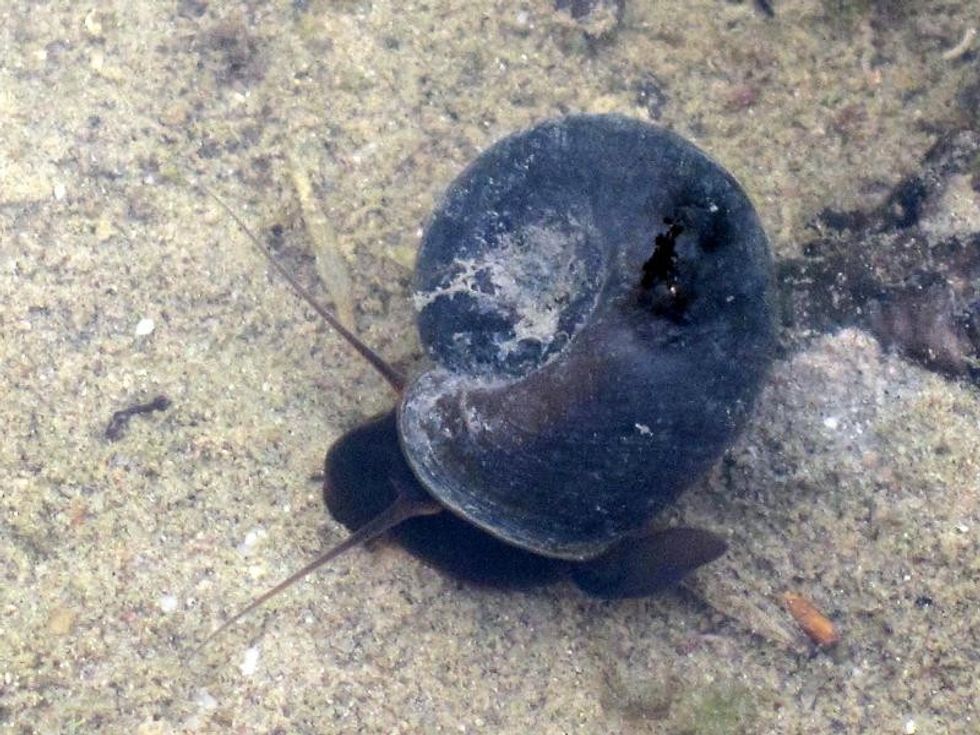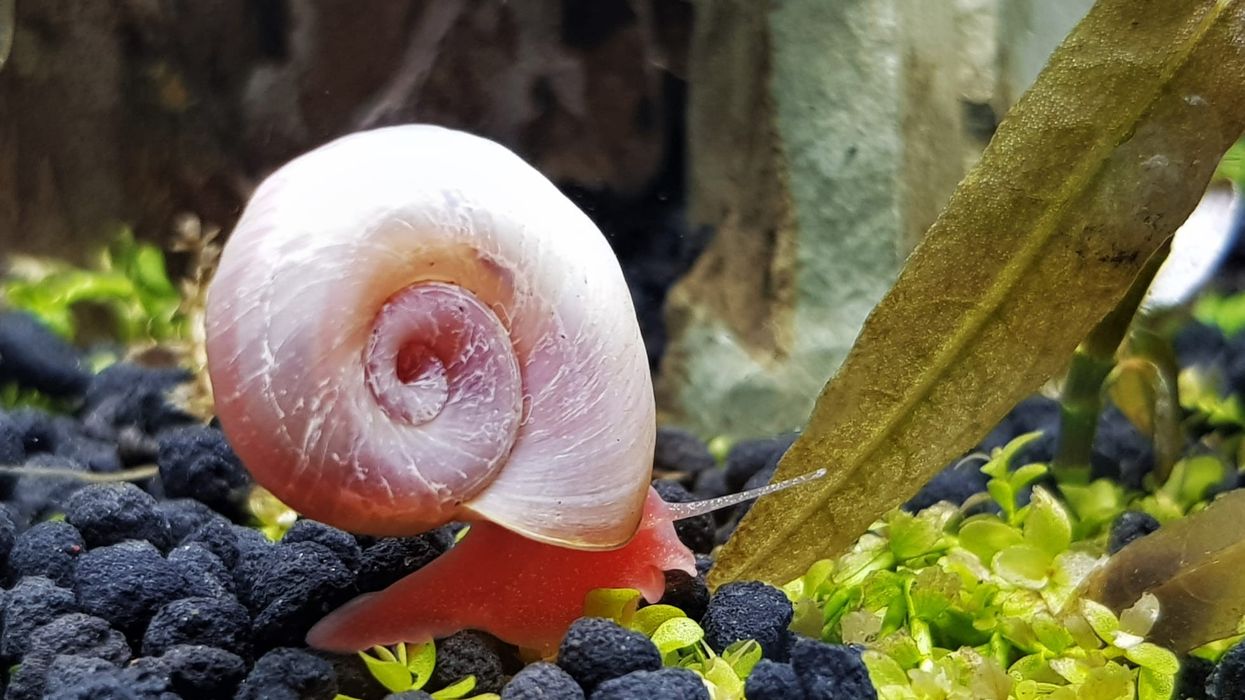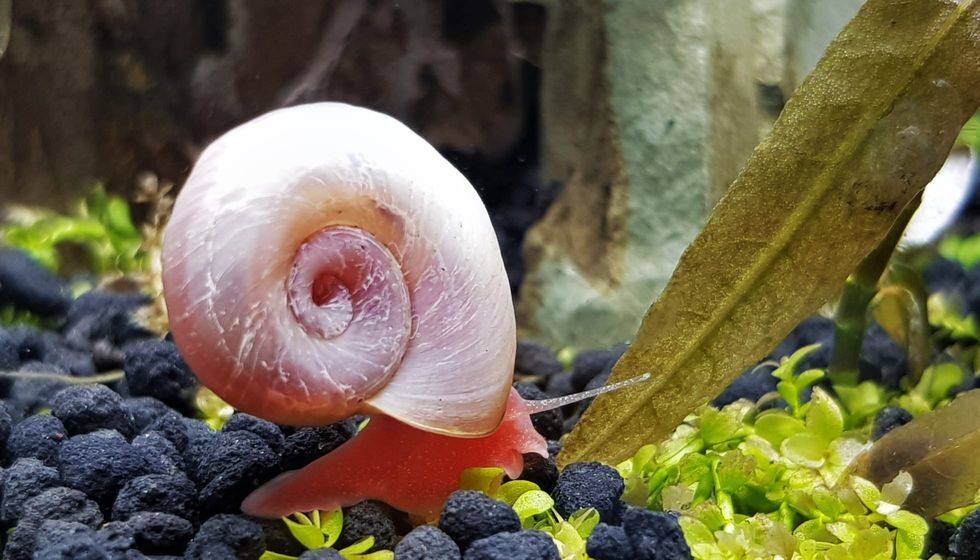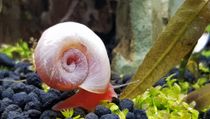Fun Ramshorn Snail Facts For Kids
Ramshorn snails are popular in the aquarium trade due to their small size and beautiful shells. Ramshorn snails or ram's horn snails are called that because they have a flat and spiral shell.
Most of these snails belong to the gastropod family Planorbidae. Ramshorn snails are very small and come in two main colors, black and red.
Older snails and snails caught in the wild look darker and a red ramshorn snail looks red because of red blood. The natural habitat of ramshorn snails is fresh, slow-moving waters.
Ramshorn snails are known to breathe air. They are often seen 'floating' along the surface of the water to get their air.
They don't have an operculum and can expel this air to sink to the bottom if they feel threatened. These snails are easy to keep in the tank but can sometimes become pests because they multiply so quickly being hermaphrodites.
For more relatable content, check out these snail facts and sea slug facts for kids.
Ramshorn Snail Interesting Facts
What type of animal is a ramshorn snail?
A ramshorn snail is a gastropod, a mollusk, and a snail.
What class of animal does a ramshorn snail belong to?
Ramshorn snails belong to the Gastropoda class of animals.
How many ramshorn snails are there in the world?
It is unclear exactly how many ramshorn snails are currently alive in the world because there are numerous species of ramshorn snails that are present all over the world. They are also very common as aquarium pets.
Where does a ramshorn snail live?
The different ramshorn snail species occur all around the world. In northwest Europe alone, there are about known species of ramshorn snails.
The Helisoma anceps species of the ramshorn snail (Planorbidae) is widely seen in the eastern parts of North America. The Helisoma anceps royalense subspecies is endemic only to Michigan's Isle Royal.
Three different Planorbella genus species are also found in Michigan. The Planorbella campanulata species is widely distributed in the northern parts of North America and the Planorbella multivolvis species has become Extinct from these parts. Planorbella smithi snail is also found in the same habitats but is Endangered.
The Bulinus truncatus ramshorn snail hails from north Africa and various other species are found in mainland Australia and Tasmania.
What is a ramshorn snail's habitat?
The natural habitat of ramshorn snails is bodies of fresh water. They are seen in slow-moving rivers, lakes, and ponds. Very few snails are known to inhabit brackish water. Most of these freshwater snails are seen in aquariums around the world.
Who do ramshorn snails live with?
Like other snails, ramshorn snails live by themselves or in small groups.
How long does a ramshorn snail live?
Ramshorn snails live for only one year. With top-quality care, their lifespan can be extended up to three years. However, many of these freshwater snails die very shortly after they are introduced to a tank.
How do they reproduce?
Ramshorn snails reproduce by mating and laying eggs. They are hermaphrodites, meaning any two organisms have the same sex and can breed to produce offspring. Ramshorn snails are known to reproduce swiftly. When entering a tank, they will breed very soon.
Eggs are laid in jelly-like clutches and clear globs that contain up to 12 eggs, each looking like a small dot. Sometimes there may be more eggs than are visible.
The small dots appear less clear and increasingly translucent after each passing day and the shape of baby snails starts becoming visible. Soon after this, the translucent snails are seen making their way out of the eggs and separating from the clutch. Newborns are whitish in color and the egg clutches can sometimes be brownish.
The entire time taken by the ramshorn snails to hatch is two to five weeks. Ramshorn snails reproduce more when they eat more.
Also, ramshorn snails are capable of sexual and asexual reproduction, meaning only one snail is enough to give birth to more snails.
What is their conservation status?
There are many different species of ramshorn snails that have different statuses in the Red List of the International Union for Conservation of Nature, but on the whole, they are of Least Concern.
Ramshorn Snail Fun Facts
What do ramshorn snails look like?

The Planorbidae family of ramshorn snails comes in mainly two different colors, red and black.
Black-colored ramshorn snails have more melanin in their skin, which is responsible for the dark coloration. The red ramshorn snails do not have melanin and they look red because of the hemoglobin in their blood.
Other snails have green hemoglobin and green blood, which is why they look green but the ramshorn snails are different as they have red hemoglobin.
Through selective breeding, people have been able to produce blue and pink ramshorn snails, but these are very rare cases. The offspring of these rare pink and blue individuals will have the wild colors of black and red.
The shells of ramshorn snails can range from translucent to entirely black. A difference in the diet influences the color of the shells. Older snails and snails caught in the wild tend to have darker shells.
The shells are circular and the opening of the shells is slanted usually to the right and their spirals are sinistral. Ramshorn snails, like other snails that breathe air, don't have an operculum, which is the plate that closes behind them when they retract into their shells.
How cute are they?
Ramshorn snails are cute and beautiful gastropods. They are tiny, peaceful, non-aggressive creatures who are popular as aquarium pets. They are like small red and black ornaments that adorn your aquarium.
How do they communicate?
Ramshorn snails have a strong sense of smell. They use it to find food.
The antennae of ramshorn snails are also very sensitive and capable of detecting food. The antennae move back and forth when ramshorn snails get excited. Also, ramshorn snails are air-breathing snails, so they are seldom observed swimming along the water's surface to obtain oxygen.
They keep their balance by regulating the quantity of air in their shells. If ramshorn snails sense danger they release the air quickly to sink to the bottom of the tank or water body.
How big is a ramshorn snail?
Ramshorn snails have a diameter of up to 1.4 in (3.6 cm) and a height of 0.2-2.4 in (0.6-6 cm). This makes them five times smaller than apple snails.
How fast can a ramshorn snail move?
Being snails, ramshorn snails are very slow, but they spend most of their time moving around and exploring.
How much does a ramshorn snail weigh?
A ramshorn snail can weigh up to 0.3 oz (8.1 g).
What are the male and female names of the species?
Ramshorn snails are hermaphrodites, so for them, there is no such thing as males and females.
What would you call a baby ramshorn snail?
A baby ramshorn snail is called exactly that, a baby ramshorn snail.
What do they eat?
Ramshorn snails eat plants, algae, dead fish, uneaten fish food, leaves, fish flakes, bottom feeder tablets, algae wafers, calcium-rich supplements, shrimp, and fresh vegetables like lettuce leaves, zucchini slices, spinach leaves. Baby ramshorn snails mostly eat soft green algae.
They themselves may get preyed upon by puffers, loaches, crayfish, gouramies, apple snails, assassin snails, clown loaches, and goldfish.
Are they poisonous?
No, ramshorn snails are not poisonous.
Would they make a good pet?
Yes, they mostly make good pets. Most aquarium pet stores will have stocks of ramshorn snails, so they're easy to get. Ramshorn snails are affordable as well, often being sold in bunches of 10 for as low as $5 or even lower than that. Ramshorn snails that have been bred selectively may cost a bit more than that.
These snails are very peaceful. They usually keep away from other fish and animals and focus on finding their own food. They can coexist with all kinds of tank mates, just not the ones that eat snails. Ramshorn snails are known to nibble away at slow-growing and delicate live plants so maybe avoid keeping those in the aquarium.
It is easy to recreate the natural environment of ramshorn snails since they are found all over the world. They prefer mostly freshwater habitats with plants.
However, brackish water should be avoided but slightly alkaline waters work great since ramshorn snails are air-breathers and they wouldn't mind the low oxygen. Fine-grain sands work best as a substrate.
Live plants should also be kept in the tank along with plants, decor can contain rocks and bogwoods, so the ramshorn snails have something to climb over. The water has to be slow-moving and the water parameters of 70-78°F (21.1-25.6°C) temperature along with a pH of 7-8.
Ramshorn snails are tiny so they can live in tanks of all shapes and sizes. A tank size as little as 4.2 gals (19 L). One to two snails can be added per gallon but keep this number to one if you have a larger tank size for a community tank.
Ramshorn snails will go into their shells if they feel threatened. Tetras, cory catfish, and danios are good tank mates since they don't feed on snails.
Amano shrimp and ghost shrimp are good mates too. Avoid crayfish since they are known to eat snails. Also, ramshorn snails do well in groups, they don't interact much, but they'll find food together without any aggression.
Ramshorn snail breeding happens quickly anyway, so even a single snail works fine. Sometimes, they can be pests because they're hardy, can adjust to different water parameters and their reproduction and growth happens quickly, but there are ways to deal with that too.
Pet owners should check the water quality regularly and get rid of uneaten food. They shouldn't wipe away all the algae, since ramshorn snails like eating algae.
A lot of calcium should be included in the diet to give them a strong shell. Not eating enough food stunts their growth and eating too much may cause a faster shell growth resulting in loss of coloration. White spots on the shell mean parasites but this is rare.
Avoid adding things that have copper as an ingredient to your tank since it is toxic to invertebrates including snails.
Did you know...
Some apple snails are all called giant ramshorn snails and Columbian ramshorn snails, and these are bigger than ramshorn snails.
Are ramshorn snails invasive?
Sometimes, ramshorn snails can become pests. This is because they multiply and develop at a very fast rate.
Because of their small size, they can make their way into an aquarium when their eggs are hidden in live plants. A population of ramshorn snails is more helpful than invasive. They keep the tank clean by eating up the excess algae as well as uneaten fish food.
They do produce feces, having too many of these ramshorn snails is not ideal. It can get hard to get rid of them, so one should think about keeping them as pets in the first place.
If your ramshorn snail population grows too dense, there are a few ways to handle the problem. You can always remove them by hand. This method takes some time and has to be done a bit regularly. Complete eradication is impossible.
Using chemicals is more effective. Copper is toxic to ramshorn snails, so copper-based medications for fish are known to kill ramshorn snails. But copper is toxic to almost all invertebrates so make sure you exercise caution.
How long does it take ramshorn snail eggs to hatch?
It takes ramshorn snail eggs anywhere between two to five weeks to hatch.
Here at Kidadl, we have carefully created lots of interesting family-friendly animal facts for everyone to discover! Learn more about some other gastropods from our blue sea slug interesting facts and limpet surprising facts pages.
You can even occupy yourself at home by coloring in one of our free printable giant African land snail coloring pages.
We Want Your Photos!
More for You
Doctorate specializing in Veterinary Medicine

Oluniyi AkandeDoctorate specializing in Veterinary Medicine
With an accomplished background as a Veterinarian, SEO content writer, and public speaker, Oluniyi brings a wealth of skills and experience to his work. Holding a Doctor of Veterinary Medicine degree from the University of Ibadan, he provides exceptional consulting services to pet owners, animal farms, and agricultural establishments. Oluniyi's impressive writing career spans over five years, during which he has produced over 5000 high-quality short- and long-form pieces of content. His versatility shines through as he tackles a diverse array of topics, including pets, real estate, sports, games, technology, landscaping, healthcare, cosmetics, personal loans, debt management, construction, and agriculture.
Disclaimer
1) Kidadl is independent and to make our service free to you the reader we are supported by advertising. We hope you love our recommendations for products and services! What we suggest is selected independently by the Kidadl team. If you purchase using the Buy Now button we may earn a small commission. This does not influence our choices. Prices are correct and items are available at the time the article was published but we cannot guarantee that on the time of reading. Please note that Kidadl is a participant in the Amazon Services LLC Associates Program, an affiliate advertising program designed to provide a means for sites to earn advertising fees by advertising and linking to Amazon. We also link to other websites, but are not responsible for their content.
2) At Kidadl, we strive to recommend the very best activities and events. We will always aim to give you accurate information at the date of publication - however, information does change, so it’s important you do your own research, double-check and make the decision that is right for your family. We recognise that not all activities and ideas are appropriate for all children and families or in all circumstances. Our recommended activities are based on age but these are a guide. We recommend that these ideas are used as inspiration, that ideas are undertaken with appropriate adult supervision, and that each adult uses their own discretion and knowledge of their children to consider the safety and suitability. Kidadl cannot accept liability for the execution of these ideas, and parental supervision is advised at all times, as safety is paramount. Anyone using the information provided by Kidadl does so at their own risk and we can not accept liability if things go wrong.
3) Because we are an educational resource, we have quotes and facts about a range of historical and modern figures. We do not endorse the actions of or rhetoric of all the people included in these collections, but we think they are important for growing minds to learn about under the guidance of parents or guardians.







